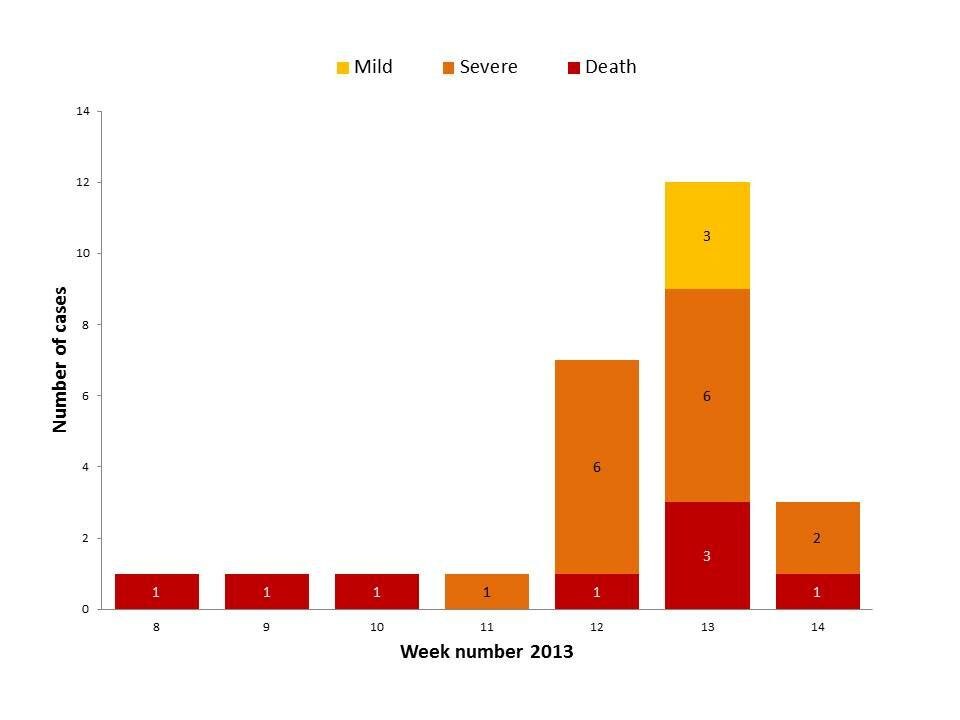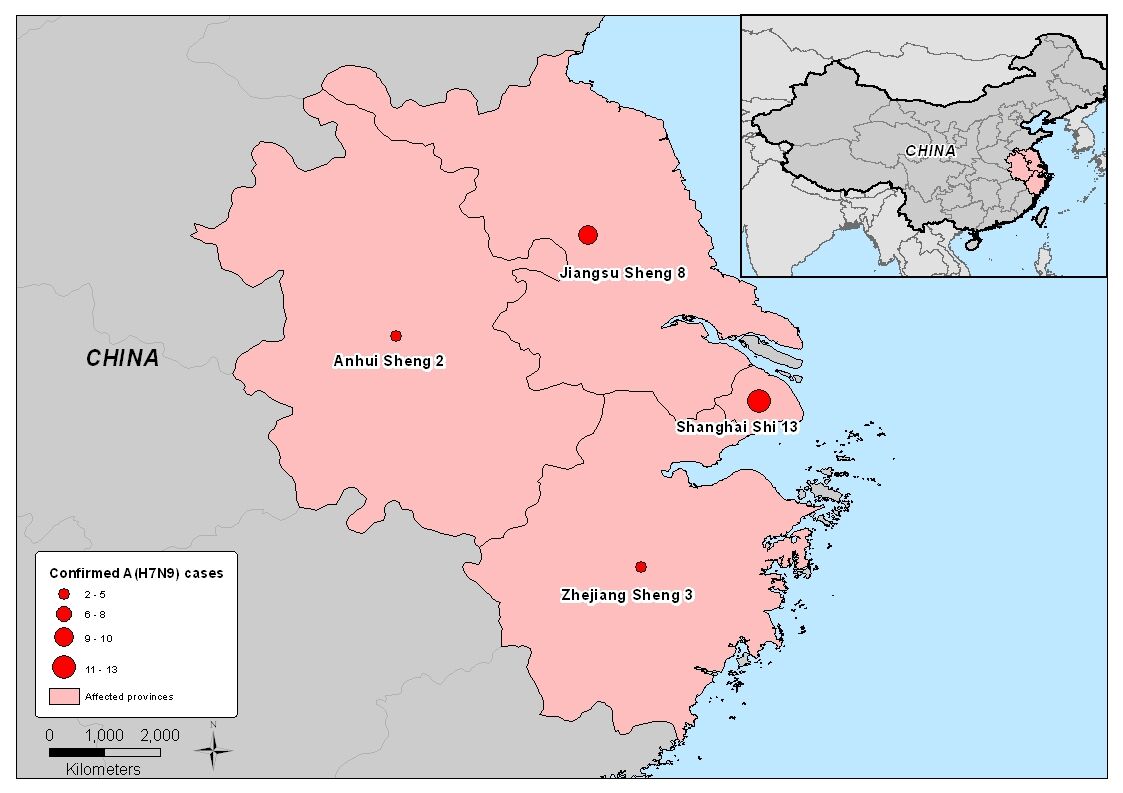Epidemiological update of 10 April: novel influenza A virus A(H7N9) in China
As of 9 April 2013, 26 human cases of infection with influenza A(H7N9) virus have been reported in four provinces of China: Shanghai (13), Jiangsu (8), Zhejiang (3) and Anhui (2). Of these patients, 8 people have died, 15 are severe cases and 3 are mild cases. No epidemiological link has been identified among cases.
On 31 March 2013, the Chinese health authorities announced that they identified a novel influenza A(H7N9) virus in three seriously ill patients.
As of 9 April 2013, 26 human cases of infection with influenza A(H7N9) virus have been reported in four provinces of China: Shanghai (13), Jiangsu (8), Zhejiang (3) and Anhui (2). Of these patients, 8 people have died, 15 are severe cases and 3 are mild cases. No epidemiological link has been identified among cases.
The source of these infections and the mode of transmission are yet to be determined. This is the first time that human infection with influenza A(H7N9) virus has been identified.
No vaccine is currently available for this subtype of the influenza virus. Preliminary test results suggest that the virus is susceptible to the neuraminidase inhibitors (oseltamivir and zanamivir).
At this time, there is no evidence of on-going human-to-human transmission. More sporadic cases are expected to be reported. The risk of disease spread to Europe is considered low, although individual cases coming from China cannot be ruled out.
ECDC is working closely with WHO and the European Commission and will continue to monitor the situation.
ECDC agrees with the position of WHO and other Centres for Disease Control (the United States and Chinese CDC) that there is no need to change travel plans for persons going to or coming from China because of the recent appearance of a novel avian influenza virus A(H7N9) that has affected humans in China. However, ECDC is repeating its standing advice to European citizens living in or visiting China that because of the presence of the novel influenza viruses, other avian influenza and zoonotic infections in live bird and animal markets (so called “wet markets”) in China and other countries in Asia should avoid visiting these markets. Direct contact with bird and animal faeces, untreated bird feathers and other animal and bird waste should also be avoided. In addition, basic rules of hand hygiene should be followed including regular hand-washing and use of alcohol-based hand rubs. This is the same advice ECDC has had in place since 2006.This epidemiological update does not change the conclusions and recommendations of ECDC’s Rapid Risk Assessment of 2 April 2013.
Figure 1: Distribution of influenza A(H7N9) cases by date of onset of symptoms, age, gender, status and province in China, as of 9 April 2013 (n=26).
Date of onset |
Age |
Sex |
Status |
Severity |
Province |
19/02/2013 |
87 |
M |
dead |
severe |
Shanghai |
27/02/2013 |
27 |
M |
dead |
severe |
Shanghai |
07/03/2013 |
38 |
M | dead | severe | Zhejiang |
15/03/2013 |
35 |
F |
alive |
severe |
Anhui |
19/03/2013 |
45 |
F |
alive |
severe |
Jiangsu |
19/03/2013 |
48 |
F |
alive |
severe |
Jiangsu |
20/03/2013 |
83 |
M |
dead |
severe |
Jiangsu |
20/03/2013 |
61 |
F | alive | severe | Jiangsu |
21/03/2013 |
32 |
F |
alive |
severe |
Jiangsu |
21/03/2013 |
79 |
M | alive | severe | Jiangsu |
22/03/2013 |
67 |
F | alive | severe | Shanghai |
25/03/2013 |
67 |
M |
alive |
severe |
Zhejiang |
25/03/2013 |
59 |
M | alive | severe | Shanghai |
27/03/2013 |
52 |
F | dead | severe | Shanghai |
28/03/2013 |
48 |
M | dead | severe | Shanghai |
28/03/2013 |
74 |
M | alive | severe | Shanghai |
28/03/2013 |
55 |
M | alive | severe | Anhui |
28/03/2013 |
85 |
M | alive | severe | Jiangsu |
29/03/2013 |
64 |
M |
dead |
severe |
Zhejiang |
29/03/2013 |
66 |
M |
alive |
mild |
Shanghai |
29/03/2013 |
67 |
M | alive | mild | Shanghai |
30/03/2013 |
25 |
F |
alive |
severe |
Jiangsu |
31/03/2013 |
4 |
M |
alive |
mild |
Shanghai |
01/04/2013 |
64 |
M |
dead |
severe |
Shanghai |
01/04/2013 |
62 |
M | alive | severe | Shanghai |
01/04/2013 |
77 |
M | alive | severe | Shanghai |
Figure 2: Distribution of influenza A(H7N9) cases in China by week of onset of symptoms, as of 9 April 2013 (n=26).

Figure 3: Distribution of cumulative number of confirmed influenza A(H7N9) cases by province in China, from 19 February to 9 April 2013.








